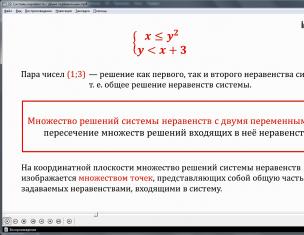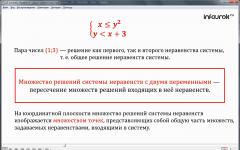The word is undoubtedly the root. It can be defined as the main morpheme of a word, containing the main lexical meaning.
In this case, only one root can be formed. For example, “rain”, “forest”, “light”. A word can also include two or more roots. In this case, the corresponding quantity is combined lexical meanings into one common thing. As an example, we can cite words such as “forest-steppe”, “word formation”, “color music”. There are also various conjunctions, interjections, which represent a separate lexeme, but do not have a root.
In cognates it is possible to alternate vowels or consonants. Such roots include milk/milk, rast/rasch/ros, etc. This is due to their origin and the general process of language development. Such phonetic alternations in the roots of words with the same root are not rare occurrence in language. In order to correctly highlight such roots in a letter, sometimes it is simply necessary to know what contributed to this. This could be the loss of nasal vowels in the Russian language due to the trend of simplification, the presence of the two most powerful dialects that made up the modern Russian language - the St. Petersburg “okaya” dialect and the Moscow “akaya” dialect, etc.
Suffix
The place of the suffix is immediately after the root. A suffix carries additional meaning and can change the basic meaning of a word. Thanks to the suffix, you can transform one part of speech into another, add emotional expressiveness, etc. For example, if you add the suffix “ik” to the word “house,” then an additional diminutive meaning appears. By adding the suffix “n” to the noun “interest,” you get the adjective “interesting.”
Based on the above, a suffix can be defined as a significant part of a word that carries additional semantic load and occupies a position after the root.
Prefix
A prefix, like a suffix, carries additional meaning and can change the main meaning of the lexeme. For example, if you add the prefix “to” to the imperfective verb “play,” it becomes a perfective verb. Being a prefix, the prefix occupies a position before the root.
Thus, a prefix can be defined as a significant part of a word that carries additional semantic load and occupies a position in front of the root.
You can highlight the stem in a letter if you decline a noun or adjective by case or conjugate a verb by person. That part of the word that remains unchanged and will form the basis of the lexeme.
Sections: Primary school
Class: 3
Goals: familiarization with the word-formation role of prefixes and suffixes in the Russian language, development of the ability to identify prefixes and suffixes in a word, development of spelling vigilance, improvement of writing skills, cultivation of accuracy, instilling interest in studying the composition of a word.
Equipment: diagrams of morphemes, tablets (word composition, vocabulary word - weather), textbook, notebook, magnetic board, magnets, lesson presentation, computer, copybooks by L.Ya. Zheltovskaya, E.N. Sokolova.
Lesson progress
1.Org. moment.
Russian language lesson. They sat down quietly.
2. Statement of the topic and purpose of the lesson.
Today in this lesson we will continue to work on the composition of the word. You will learn what a prefix and suffix are. Do you find out where they are in a word and what they serve for in our language? We will learn to form words with the same root using prefixes and suffixes.
We opened our notebooks. We wrote down the number, class work and the topic of our lesson “Prefixes and suffixes”.
3.Checking homework.
1). At home you must repeat the parts of the word you have already learned. I will give one of you task cards. Read the tasks carefully and complete them on the card.
I hand out task cards. (Appendix 1).
2). I show the others the morpheme. Tell me what it means.
This graphic image root Root– this is the common (identical) part of words with the same root. (Examples).
Read the words: table, table, dining room, century.
Name the extra word. Prove why? (Century.)
How can you name the rest of the words? (Same root.)
This is a graphical representation of the ending. Ending – This is a variable part of a word that serves to connect words in a sentence.
(Examples.)
4. Calligraphy.
Copybook p.9, No. 30.
Read a couple of words. Can we say that these pairs are cognate words?
Select the root and ending. (On the chain.)
The copybooks were closed.
5. Work on new material.
I think it's time to get acquainted with new morphemes called prefix And suffix.
Let's write down a sentence from dictation:
Frosts are light morning frosts in spring or autumn.
(Check.)
1). Write out the words with the same root from this sentence.
(Frost, frost.) (Check.)
2). Select: ending, root.
3). Compare these words.
frost?
(root, ending).
What parts does a word consist of? frost?
(Root, ending and other parts of the word.)
These are new morphemes. Each has its own name, place in the word and its own role.
For is a prefix; it always comes before the root. It stands out graphically like this.
K- is a suffix; it always comes after the root. It stands out graphically like this.
This begs the question: “What are prefixes and suffixes used for?”
How do you think?
(For the formation of new words.)
6. Observation of features consoles.
1. - What is prefix, read rule us. 66.
2. Game.
I suggest playing a fairy tale game. The hero of this tale will be the Dwarf. We will write a short story about the journey of this Dwarf. I'll start, and you continue.
One morning the Dwarf decided to go on a journey. He came out from the house and...
(went, crossed, approached, ascended, descended, left, walked around, reached, entered, entered.)
Write down these words and highlight the prefixes.
CONCLUSION. – What is a prefix?
3.Work from the textbook, p. 67, ex. 146.
Independent work.
We are working on options.
1st century - from the word - walk
2nd century - from the word - fly
Select the root and prefix. Examination.
7. F I Z M I N U T K A
8. Observation of features suffix.
What other part of the word did you meet today?
(Suffix.)
- – What is a suffix?
- – Now you are practicing forming words with the same root using suffixes. This will help us exercise 147 along the “chain”.
- CONCLUSION. – What is a suffix?
Read the rule on p. 67.
What semantic connotation did the suffix bring to the meaning of the word?
9. Vocabulary work.
Today you will learn a new vocabulary word.
Read this word - P ABOUT YEARS.
Which syllable is stressed?
What unstressed untested vowel should you remember?
Write this word down.
Form words with the same root from the word P ABOUT YEARS using suffixes.
(Weather, weather, weather (conditions) ).
What suffixes did you use to form these words?
Make up a sentence with the word weather.
Recording (with commenting).
The weather is cold outside.
Emphasize main members offers.
10. Lesson summary.
Name the topic of our lesson.
What new did you learn in the lesson?
What did you study?
What are they used for? consoles And suffix?
11. Homework.
Ex. 150 s. 68, rules p. 66-67.
The lesson is over. Thank you. Well done.
Appendix 1
Card No. 1.
Forest, forests, forest.
Meadow, meadows, meadow, in the meadow.
Card No. 2.
In the written words, highlight the root () and ending ().
Heavy, heavy, heavy.
Birch, birch, birch, on a birch.
Card number 3.
In the written words, highlight the root () and ending ().
Field, field, clearing, clearing.
Sea, sailor, marine.
1. Suffix is a morpheme that comes after a root and is usually used to form new words, although it can also be used to form the form of one word.
For example: kind - kindness(suffix - from- word-formative), kinder, kinder(suffix - her- formative, forms a form comparative degree adjective; suffix - eish- formative, forms a form superlatives adjective).
Pay attention!
In some cases, the suffix -j- may not receive a special graphic designation in the word. Its presence can be indicated by vowels e, ё, yu, i in the position after a consonant or a dividing ь, for example: Volga region[j] e[volga], Zaonezh[j] e[zΛn’ezhj].
2. Most suffixes are used to form new words.
Teach - teacher, teacher, teacher.
There are relatively few formative suffixes in the Russian language. The most important among them are the following:
suffixes of the comparative and superlative degrees of the adjective: -ee (-ey), -e, -she, -eysh-, -aysh;
Faster, faster, more expensive, older, deepest, wisest.
past tense verb suffix -l;
I came and found out.
suffix imperative mood verb -i;
Take it, lead it.
some noun suffixes as indicators of the plural and singular;
Wed: citizen(units) - citizens(plural); Friend(units) - Friends(plural; it is created not only due to the ending -я [а], but also due to the suffix -j- - [druz’j а́]); son(units) - son I(plural; it is created not only due to the ending -я [а], but also due to the suffix -овj - [снΛв’j а́]); duckling ok(units) - ducklings(plural).
some noun suffixes as indicators of indirect cases.
Wed: mother- (No) mater and, time- (No) times and
The spelling of suffixes depends on the part-speech nature of the word and will therefore be considered when characterizing the corresponding parts of speech.
Pay attention!
1) In linguistics there is no unity in determining the status of the indicator of the indefinite form of the verb (infinitive) - -ть, -ти, -ч ( run, carry, take care). Some researchers characterize these morphemes as endings, others as suffixes. In this tutorial we look at infinitive indicator(-t, -ti, -ch) as an ending (!).
2) In linguistics there is no single point of view on the participle affiliation of participles ( reading, read, read, read) and gerunds ( reading, having read). In some manuals, participles and gerunds are characterized as independent parts of speech (in which case the corresponding suffixes will be derivational), in others - as special forms of the verb (in which case the same suffixes will be formative). In this manual, participles and gerunds are considered as independent parts of speech.
3. Like roots and prefixes, suffixes can change their appearance. At the same time, as in the roots, alternations of consonant and vowel sounds are observed here. In particular, “fluent vowels” are possible.
Wed: knizh-k-a - knizh-ek; slid-k-y - slid-ok, funny-n-oh - funny-on, old-etc - old-ts-a, saucer-ts-e - saucer-etc.
Quite regularly, alternations of consonants and combinations of sounds are observed in suffixes (k / h, ova / уj).
Wed: knizh-k -a - knizh-ech -k-a, kom-ok - kom-och -ek, pir-ova -t - pir-uj -yu.
4. In general, when identifying suffixes and complexes of suffixes, it is necessary to focus on the words from which the given word. In this case, it is convenient to use a paraphrase with such a cognate word.
For example:
- Let's compare morphemic composition nouns: Sasha, cherry, pea.
In the word Sashenka ( Sash-enk-a) the root stands out Sash- (Sasha) and suffix -enk(A): « Sashenka- diminutive for Sash A».
In the word cherry ( cherry-to-a) the root stands out cherries with a fluent vowel ( cherry) and suffix -To(A): « Cherry- little cherry I».
In the word pea ( pea) the root stands out peas with alternating consonants X/w (peas) and two suffixes: suffix -in- (pea): « Pea- single component of peas”; suffix -To(A): « Pea- small pea ina».
- Let's compare the morphemic composition of adjectives: dreamy and conscious.
In the word dreamy ( dreamy) the root stands out dream- (dream) and three suffixes: verb suffix -A- (dream): « Dream- indulge in dreams am"; suffix -tel with the meaning “doer” ( dreamer): « Dreamer- one who loves dreams at"; adjective suffix -n(th): « Dreamy- such as a dreamer; typical dreamer yu».
In the word conscious ( conscious) the root stands out know (know) with prefix co- (co-knowledge), as well as one suffix -teln(th): « Conscious- one who is correctly conscious ayot, understands the surrounding reality.” Suffix -tel in this case it is not highlighted, since there is no noun in Russian conscious.
Pay attention!
Most typical mistakes when highlighting suffixes are the following.
1) Assigning the final letters of a suffix to the ending. This happens especially often with suffixes: -enij ( e) - possession-enij -e, -tij(e) - take-tij-e, -ij(e) - narcissist-ij-e, -j(e) - happiness-j-e, -j(e) - old-j-e, -atsij(I) - delegation-atsij-i, -ij(I) - arm-ij-i. In all these cases andj or j refer to the suffix, not the ending (!).
2) Attributing part of a root or part of a previous suffix to a suffix (usually when there are identical sounds and letters at the end of a word).
3) Non-distinction between individual suffixes and the sum of suffixes.
Wed: inert- awn (from osn th, Where kosn- - root), ready-ness (from ready th, Where ready- - root), gram-n- awn (cf.: charter - A → diploma-n - th → gram-n- awn).
Answers in Russian. 3rd grade. Test work. Kanakina V.P., Shchegoleva G.S.
Composition of the word
Prefix. Suffix
Answers to pages 28 – 30
1. Read. Fill in the missing words in the sentences.
Suffix- this is the significant part of the word that comes after the root. Prefix- this is the significant part of the word that comes before the root.
2. Read. Mark √ which significant parts of the word are used to form new words.
√
suffix
√
prefix
3 ∗ . Read it. Find words with prefixes. Select consoles.

(L. Tolstoy)
Underline the verb in which the prefix means “repeat the action again.”
Identify the root in words with the same root.
4 ∗ . Read it. Form from each word and write down a word with the same root with a different prefix. Highlight the prefixes in the words.
under/ run - y/ run for/ scream - on/ scream
for/ sparkle - By/ sparkle O/ look - re/ look
from/ swim - at/ swim With/ ask - By/ ask
Underline the verbs in which the prefix means “the beginning of an action.”
5. Read. Find a verb with two prefixes. Highlight the prefixes in the verbs.
Chu, it thundered behind the cloud, 
(F. Tyutchev)
6 ∗ . Read it. Mark √ words that do not have prefixes. Highlight prefixes in other words.

7. Read. Fill in the missing letters in the words. Write down the word from which the words of each row were formed. Highlight the suffixes in the words.

Underline words with diminutive suffixes.
Write down the adjective and highlight all the significant parts of it.

8 ∗ . Read it. Fill in the missing words.

(N. Sladkov)
Highlight the suffixes in the words - names of baby animals.
9 ∗ . Read it. Fill in the missing suffixes in the words.
Underline the words that consist of a root and an ending. Highlight all the significant parts of the word in other words.
10 ∗ . Read it. Write down the missing words in the memo.
How to determine the suffix in a word?
1) I select words with the same root without a suffix and with other suffixes.
2) I select the part that comes after the root. This part will be the suffix.
11 ∗ . Read it. Mark √ which words contain these suffixes.
-hic -chick -ok
Answer:
Root- This main part a word that contains the basic meaning of all related words of the same root. (For example: mushroom, mushroom OK, mushroom Noah, mushroom nickname - root mushroom-).
Base word- This is a part of a word without ending. The basis may include a prefix, root, suffix. ( mushroom oh, the basis mushroom-)
End is a variable part of a word that serves to connect words in a sentence. (at the house A, to the house y, for the house ohm).
End Not serves to form new words!
Prefix- this is a significant part of the word that comes before the root and serves to form new words. ( at ran from ran for ran)
Suffix- this is a significant part of a word that comes after the root and serves to form new words.
(house, house IR, house ov oh, home looking for e)
Algorithm for parsing words by composition:
1. Read the word. Change the form of the word. Highlight the ending.
2. Highlight the base of the word - the whole word without ending.
3. Choose a few related words. Select the common part - the root.
4. Specify the prefix.
5. Specify the suffix.
Ticket No. 4.
Rule “Testable unstressed vowels at the root of the word.”
-How to check for an unstressed vowel at the root of a word?
- How to check words with two unstressed vowels at the root of the word?
- Unverifiable unstressed vowels at the root of the word.
Answer:
- To check an unstressed vowel in the root of a word, you need to choose a word with the same root or change the word so that the stress falls on this vowel.
(m O rya - m O re, p e ka - r e chka, etc.) .
To check two unstressed vowels in the root of a word, you need to select two test words (same root or change the word) so that the stress falls on these vowels. (h e l e neli - s e lazy, green e ny)
Words with an unverified unstressed vowel at the root of the word must be memorized or looked up in the dictionary. (p e cash, g O r And umbrella)
Ticket number 5
Spelling of consonants according to deafness-voicing at the root of a word
Answer:
To check the spelling of a voiceless or voiced consonant at the root of a word, you need to select a related word so that the consonant being checked is followed by a vowel or voiced consonant (l, p, m, n). (Moro h - Moro PS, Moro zn oh, oh h ko – y ze nky)
Ticket number 6
Spelling unpronounceable consonants at the root of a word
Answer:
1. To check unpronounceable consonants, you should find a related word in which the consonant sound being tested is pronounced clearly (before the vowel and at the end of the word): rope T nick - cable T glasses, cable T b, weight T nickname - weight That point, weight T b.
2. If it is impossible to find a test word, then the spelling of the consonant must be remembered: chu V to work.
Ticket number 7
Spelling of separating signs b and b
Answer:
Separating ъ ( solid sign) is written after consoles ending in a consonant before vowels e, e, yu, i. (By d ъ e zd, ra h ъ I snil)
Dividing b ( soft sign) written after consonants before vowels e, e, yu, i, and(chair T b I nin, V b yu ha, solo V b And)
Ticket number 8
Transfer rules
Answer:
1. Words are transferred from one line to another syllable by syllable: osi-na, autumn, tea-nick, boy.
2. When hyphenating, you cannot leave one letter on a line and you cannot transfer one letter to another line: i/ma, aroma .
3. The letters J, b, b are not separated from the previous letters: war, rails, rise.
4. If a word contains double consonants (two identical letters), then one is transferred, and the second remains on the line: van-na, autumn-niy, story-tale.
Ticket number 9
Noun. Initial form.
Morphological characteristics.
Answer:
Noun Who? What? and stands for objects, people, animals, natural phenomena, etc.
Initial form – I.p., singular. (answer to the question who? or what?).
Morphological characteristics:
1) Constant:
· own (indicates full names of people, names of animals, names
literary works, newspapers and magazines,
or common noun
· animate (denotes only people and animals, answering the question who?)
or inanimate (answer to the question what?)
· gender (m.r. - he, my; f.r. - she, my; middle r. - it, mine),
· declination (1,2 or 3).
2) Non-permanent:
· number (singular or plural) (There are nouns that are used only in singular form, for example: milk, sour cream, rye,
as well as nouns that are used only in the plural form,
For example: holidays, gates, scissors.
For nouns that are used only in the plural form, gender and declension are not determined.)
Ticket number 10
What is declination? Cases of nouns.
How to determine the case of a noun.
Answer:
Declension- this is changing nouns by case using questions.
There are 6 cases in Russian:
To determine the case of a noun, you need to:
1. Find the word on which this noun depends.
2. Ask a question from the main word to the noun.
3. Determine the case based on the question and preposition.
Ticket number 11
Adjective. Initial form.
Morphological characteristics
Answer:
Adjective - independent part speech that answers questions Which? which? which? which? whose? whose? whose? whose? and stands for attribute of an object.
Initial form – I.p., m.r., singular. (answer to the question which? or whose?).
Morphological characteristics:
gender (singular only)
An adjective always has the same gender, number and case as the noun on which it depends.
Ticket number 12
Verb. Initial form.
Morphological characteristics.
Answer:
Verb- an independent part of speech that answers questions what to do? what to do? And denotes action or condition of the item.
Verbs in initial (indefinite) form answer questions about what do? what to do? For verbs in an indefinite form, it is impossible to determine the morphological characteristics.
Morphological characteristics:
1) Constant:
· conjugation (1 adjective or 2 adjectives) only in the present and future tense
2) Non-permanent:
tense (past, present or future)
· number (singular or plural)
· person (1, 2 or 3) only in present and future tense
· gender (m.r., zh.r. or sr.r.) only in the past tense, singular
Ticket number 13
Pronoun. Initial form.
Morphological characteristics.
Answer:
Pronoun- independent part of speech, which points to an object or person, but does not name it.
Personal pronouns of the 1st and 2nd persons answer the question who?, and pronouns of the 3rd person answer the questions who? or what?
Personal pronouns are used instead of nouns.
Initial form personal pronoun - this is the nominative case.
Morphological characteristics:
1) Constant:
· person (1st person – I, we; 2nd person – you, you; 3rd person – he, she, it, they)
· number (singular or plural)
· gender (m.r., w.r. or s.r.) only in the 3rd person, singular
2) Non-permanent:
When changing a personal pronoun by case, not only its ending changes, but also the word itself.
Ticket number 14
Offer. Types of sentences according to the purpose of the statement and intonation. Common and uncommon proposals.
Answer:
Offer- this is a word or several words interconnected in meaning, expressing a complete thought.
Offer for purpose of the statement It happens:
Narrative in which something is reported (narrated) ;
It's raining outside.
interrogative in which they ask about something ;
Will you be home early?
motivating in which they advise to do something, order, encourage to action .
Bring me a notebook.
By intonation there are offers exclamation and non-exclamation A sentence that is pronounced with strong feeling is called exclamatory. At the end of such a sentence there is an exclamation point (!) What a wonderful day today!
At the end of the narrative and incentive offer most often a period is used; a question mark is placed at the end of an interrogative sentence.
According to availability minor members offers are divided into








